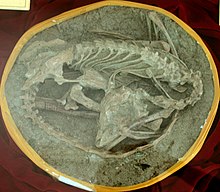Mei long
| Mei long | |
|---|---|

| |
| Fossil specimen | |
| Scientific classification | |
| Domain: | Eukaryota |
| Kingdom: | Animalia |
| Phylum: | Chordata |
| Clade: | Dinosauria |
| Clade: | Saurischia |
| Clade: | Theropoda |
| Family: | †Troodontidae |
| Subfamily: | †Sinovenatorinae |
| Genus: | †Mei Xu & Norell, 2004 |
| Species: | †M. long
|
| Binomial name | |
| †Mei long Xu & Norell, 2004
| |
Mei (from
), means sleeping dragon.Description


Mei is a
As a basal troodontid, unlike advanced troodontids, it has a bird like hip structure shared with many advanced maniraptorans.
Palaeoecology
Mei lived in the Early
There were many species of small birdlike theropod dinosaurs living in the area, although most of them were slightly larger than Mei. This probably led to a lot of niche partitioning. There were only five or six species of herbivorous non-theropod dinosaurs, however, and a large and varied fauna of early
Mei probably fed on small lizards and insects on the forest floor. It probably climbed trees as well to shelter from larger predators, and was probably not omnivorous. Judging by the length of the legs, it was a fast runner. Nothing is known about its nesting habits.[citation needed]
When the first fossil of Mei was discovered, scientists were charmed to see the fossil in a birdlike sleeping posture. Mei long means 'sleeping dragon' in Chinese. The animal had probably died from carbon monoxide poisoning, then became entombed in ash.[citation needed]
See also
- Timeline of troodontid research
- Changmiania
 The dictionary definition of 寐 at Wiktionary
The dictionary definition of 寐 at Wiktionary
References
External links
- Mei long at the American Museum of Natural History
